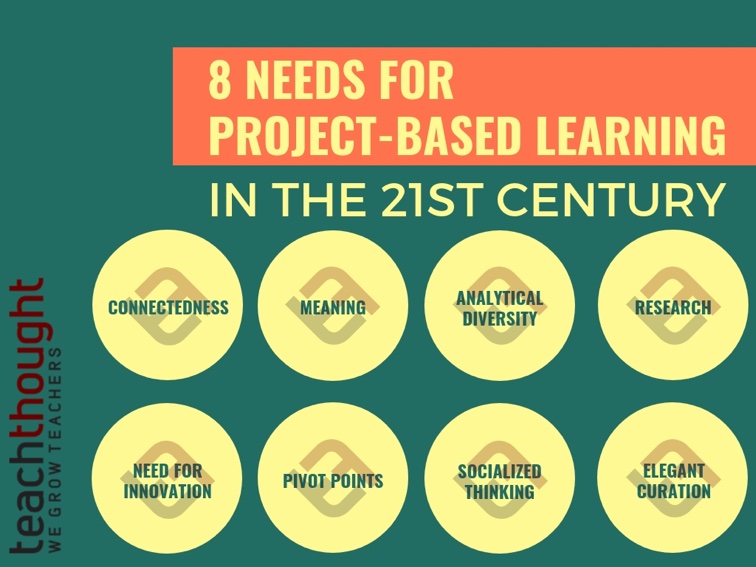

by terry hike
We recently presented a definition of project-based learning and looked at: The essence of project-based learning design.
We also Differences between ‘doing a project’ and project-based learningvarious Project-based learning resources, Project-based learning appAnd suggested ways to: Using iPad in project-based learning.
And I shared some practical ideas about it. Better education through project-based learning also.
But what may be missing from these posts is simply the nature of 21st century project-based learning. What does it look like? What is the evidence that this continues to happen? What should be built into the design of every project or required curriculum so that students can move from just a ‘project’ to a fully modern learning experience that parallels the connected world in which they live?
We tend to think of project-based learning as focused on research, problem-solving planning, authenticity, and inquiry. Collaboration, resourcefulness, and networking are also important. Dozens of characteristics are ‘fit’ for project-based learning. The program’s popularity stems above all from its general flexibility as a curriculum framework. Almost anything can be done, taught, assessed, and connected within the context of a well-designed project.
But what if you had to nail down a few (or two) bullet points for modern, connected, place-based, and often digital, project-based learning? If so, you might find the following useful:
8 Requirements for 21st Century Project-Based Learning
1. Connectivity
Or connectivity. Interdependence – however you want to express it. The idea is what this project connects to. community? hope? App? Do you have any existing projects already in progress? Social challenge? Some kind of conflict? Is there anything you can’t completely solve?
Connectivity allows students to identify the right scale for their work. (In fact, ‘scale’ can be an item in itself.)
2. Meaning
‘Meaning’ is always first personal and then academic (when it becomes academic). Achieving this kind of meaning requires authentic audience, purpose, and collaboration set in real, intimate communities that share history, space, and meaning with learners.
3. Diversity
Diversity in purpose, scale, audience, digital media, potential resources, existing models, related projects, etc. This kind of diversity must first be analyzed on the part of the project manager, i.e. the student.
This may also be a matter of diversity and inherent complexity without differentiation for students who struggle with certain elements of project-based learning as a kind of set of training wheels until they get their balance. And when do you do that? Add it again right away.
4. Research
This is neither sexy nor attractive. This is a big part of the ‘work’ of any project.
Examine the history of the problem or problem. Understand the subtleties of given demographic data. Analyze the reliability of information. Identify how technology can help or distract you (or rather, them) from the heart of the matter. This kind of knowledge can help you turn problems into opportunities.
5. The need for creativity and critical thinking
Among other topics, the 21st century is about niche markets, innovation, and scale. That means seeing an opportunity and designing something that works at a given scale and a clear scale.
But too often creativity is encouraged without being required. Points are awarded, columns are added to the rubric, and teachers explicitly require it, but designing a project that fails without creativity or helping students design their own projects is a completely different matter.
Thinking laterally, thinking outside the box, and making the most of existing models are all part of 21st century learning.
6. Pivot point
Perhaps its most modern characteristic is its ability to pivot with agility as circumstances, data, and requirements change. The world is changing rapidly, and the ability to adapt is a sign of incredible strength. Transitioning to new digital media, audiences, programming languages, time periods, purposes, or other parameters is critical to survival in the 21st century.
When a student designs a kit to help third world communities test water quality, and instead uses Google Maps to find a way to help specific communities share their water cleaning techniques. This is the key, this is how creativity works.
You’re building an app that helps people find restaurants, but did you know that people are using it more to make lunch dates with friends? pivot.
Are you looking for great resources to build an art gallery and house your book collection? pivot.
When students are able to ‘pivot’ within their project development, they demonstrate that they can see both micro-details and macro-context. This in itself is a very surprising assessment.
7. Socialization
This is ideally achieved through orthodoxy. Purpose and AudienceBut there’s more to it than that.
See also Harness real audiences in project-based learning
Socialization of ideas through connecting, collaborating, publishing and social curating (see more below). Ideally, this will be done in multiple media formats and, if possible, in multiple languages. The English- and angle-centered image of education, especially educational technology, is quickly coming to an end.
You don’t need to socialize every aspect of every project, but for the sake of educational transparency and a shared journey, sharing, socializing, and choosing who to collaborate with in the future can be powerful.
8. Elegant curation
Poor curation is saving emails, bookmarking tweets, or randomly pinning them to boards that no one will read and students will never refer to again.
Elegant curation is about preserving the ‘thing’ while respecting the ‘thing’ itself. It shows without losing meaning or fullness. As technology continues to change, it’s important to capture both what’s stored and what’s in it, and to do so in a way that’s accessible to yourself and others.
8 Requirements for 21st Century Project-Based Learning

